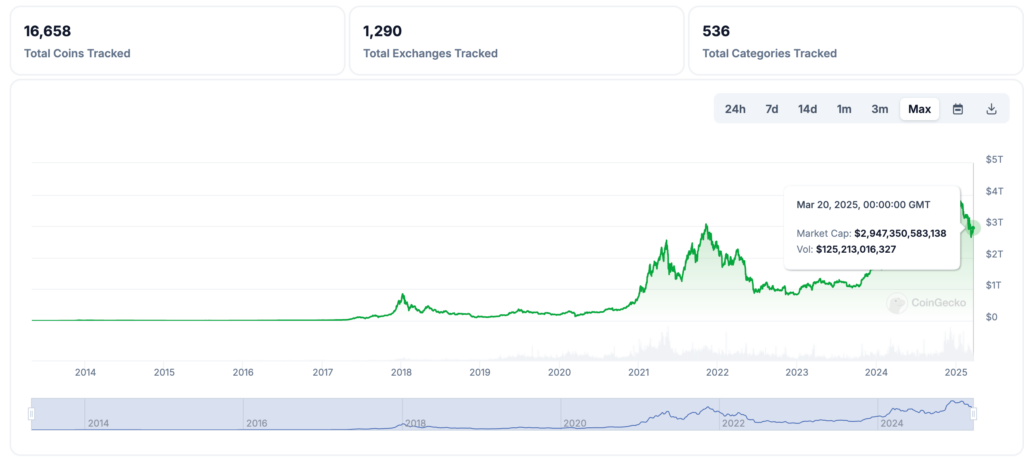In the fast-paced world of cryptocurrency, terms like “market cap” are thrown around constantly—but what do they really mean? Whether you’re a seasoned investor or a curious newcomer, understanding market capitalization (often shortened to “market cap”) is essential for navigating the crypto landscape. It’s a key metric that offers insights into a cryptocurrency’s size, stability, and potential. In this in-depth guide, we’ll explore everything you need to know about crypto market cap: what it is, how it works, how you can use it, how to calculate it, why it matters for investing, and how it stacks up against other metrics. By the end, you’ll have a solid grasp of this cornerstone concept and be better equipped to make informed decisions in the crypto space.
What is Market Cap in Cryptocurrency?
At its core, market capitalization is a measure of the total value of a cryptocurrency in the market. Think of it as a snapshot that tells you how much a cryptocurrency is worth based on its current price and the number of coins available to the public. It’s a metric borrowed from traditional finance—where it’s used to value companies in the stock market—and adapted to the decentralized world of digital currencies.
Market cap, short for market capitalization, is a metric used to measure the total value of a cryptocurrency. It is calculated by multiplying the current price of a cryptocurrency by its total circulating supply. This straightforward formula gives investors a quick way to assess a cryptocurrency’s scale and significance.
Breaking It Down:
The Role of Circulating Supply
To fully understand market cap, you need to know what “circulating supply” means. Circulating supply refers to the number of coins or tokens that are actively available to the public and traded in the market. It doesn’t include coins that are locked away (e.g., in smart contracts), reserved for future release, or held by the project’s founders or team. For example, a cryptocurrency might have a “total supply” of 1 billion coins, but if only 500 million are circulating, the market cap is based solely on those 500 million.
This distinction is crucial because it affects how we interpret a cryptocurrency’s value. A large total supply with a small circulating supply might suggest future dilution if more coins are released, while a fully circulating supply gives a clearer picture of the current market value.
Why Market Cap Matters
Market cap isn’t just a number—it’s a lens through which you can view a cryptocurrency’s place in the ecosystem. A high market cap, like that of Bitcoin or Ethereum, often signals a well-established, widely adopted asset. A lower market cap might indicate a newer, riskier project with room to grow (or fail). As eToro puts it, “Market cap is a key indicator of a cryptocurrency’s dominance and popularity. A high market cap usually indicates a cryptocurrency that has been around for a while, has a strong community, and is less volatile.”
How Does Market Cap Work?
Market cap works by combining two dynamic variables—price and circulating supply—to create a single, easy-to-digest figure. Let’s explore how this plays out in practice.
The Formula in Action
The calculation for market cap is simple:
Market Cap = Current Price per Coin × Circulating Supply
Imagine a cryptocurrency called “CryptoX.” If CryptoX has a circulating supply of 100 million coins and each coin is trading at $5, its market cap would be:
Market Cap= 5 × 100,000,000 = 500,000,000 USD
That’s $500 million—a figure that instantly tells you CryptoX’s total market value.
A Real-World Example: Bitcoin
Let’s apply this to Bitcoin, the king of cryptocurrencies.
As of March 23, 2025, Bitcoin’s price is around $84,000, and its circulating supply is approximately 19.5 million coins. Plugging these numbers into the formula:
Bitcoin Market Cap = 84,000 × 19,500,000 = 1,638,000,000,000 USD
That’s $1.638 trillion! This massive market cap reflects Bitcoin’s dominance and widespread adoption.
Dynamic Nature of Market Cap
Market cap isn’t static—it fluctuates with changes in price and, occasionally, circulating supply. If Bitcoin’s price drops to $80,000, its market cap becomes:
80,000 × 19,500,000 = 1,560,000,000,000 USD
That’s a $78 billion drop, just from a $4,000 price change. This volatility highlights how sensitive market cap is to market movements, making it a real-time indicator of a cryptocurrency’s perceived value.
How to Calculate Market Capitalization
Calculating market cap yourself is straightforward if you have the right data. Here’s a step-by-step guide:
- Get the Current Price: Find the latest price of the cryptocurrency. You can check this on platforms like CoinGecko or TradingView, which aggregate prices from multiple exchanges.
- Find the Circulating Supply: Look up the number of coins in circulation. This is usually available on the same platforms or the cryptocurrency’s official website.
- Do the Math: Multiply the current price by the circulating supply.
For example, let’s calculate the market cap of Ethereum.
Suppose Ethereum’s price is $3,300, and its circulating supply is 120 million coins:
Ethereum Market Cap = 3,300 × 120,000,000 = 396,000,000,000 USD
That’s $396 billion—a hefty sum that underscores Ethereum’s importance in the crypto world.
Tools to Simplify the Process
You don’t always need to calculate market cap manually. Websites like CoinGecko and TradingView provide up-to-date market cap figures for thousands of cryptocurrencies, along with charts showing historical trends. These tools save time and ensure accuracy, especially since prices and supplies can change rapidly.
How Can Market Cap Be Used?
Market cap isn’t just a theoretical concept—it’s a practical tool for investors, analysts, and enthusiasts. Here are some key ways it can be applied:
1. Comparing Cryptocurrencies
Market cap lets you quickly compare the relative size of different cryptocurrencies. Bitcoin’s $1.638 trillion market cap dwarfs Ethereum’s $396 billion, which in turn overshadows smaller coins like Cardano or Solana. This comparison helps you understand the hierarchy of the crypto market and identify dominant players versus emerging contenders.
2. Portfolio Allocation
Investors often use market cap to balance their portfolios. For example:
- Large-Cap Coins (e.g., Bitcoin, Ethereum): These have market caps in the tens or hundreds of billions and offer stability and lower risk.
- Mid-Cap Coins (e.g., Chainlink, Polkadot): With market caps in the millions to low billions, these offer a mix of growth potential and moderate risk.
- Small-Cap Coins (e.g., new altcoins): With market caps under $100 million, these are high-risk, high-reward opportunities.
You might allocate 60% to large caps for safety, 30% to mid caps for growth, and 10% to small caps for speculation.
3. Tracking Market Trends
The total market cap of all cryptocurrencies—tracked on platforms like CoinGecko’s Global Charts—reveals the health of the crypto market. A rising total market cap (e.g., from $2 trillion to $3 trillion) signals growing investor interest and a bull market, while a decline might indicate a bearish phase.
4. Risk Assessment
Market cap can gauge a cryptocurrency’s volatility and risk. Large-cap coins are typically less volatile because their price is supported by widespread adoption and liquidity. Small-cap coins, with less market presence, can see dramatic price swings—offering big gains or losses.
5. Spotting Opportunities
Low market cap coins might be undervalued gems with room to grow. If a $10 million market cap coin doubles in value, it’s still only $20 million—a small blip compared to Bitcoin. But that same doubling for Bitcoin would be a trillion-dollar jump, far harder to achieve. This makes market cap a starting point for identifying high-growth prospects.
Why Does Market Cap Matter in Crypto Investing?
Market cap is a cornerstone of crypto investing for several reasons. Let’s break it down:
1. Size and Stability
A high market cap often means a cryptocurrency is well-established. Bitcoin and Ethereum, with their massive market caps, have proven staying power, strong communities, and widespread use. As eToro notes, “A high market cap usually indicates a cryptocurrency that has been around for a while, has a strong community, and is less volatile.” This stability appeals to conservative investors.
2. Growth Potential
Conversely, a low market cap might signal untapped potential. A $50 million market cap coin could grow 10x to $500 million more easily than Bitcoin could grow 10x to $16 trillion. However, this potential comes with higher risk—small-cap coins are more susceptible to failure or manipulation.
3. Market Dominance
Market cap reflects a cryptocurrency’s influence. Bitcoin’s dominance (its market cap as a percentage of the total crypto market cap) often hovers around 40-60%, showing its outsized role. A declining dominance might suggest altcoins are gaining ground, a key signal for investors.
4. Investor Confidence
A growing market cap can indicate rising confidence in a project. If a coin’s price and market cap climb steadily, it might reflect strong fundamentals or hype—both of which attract investors. Conversely, a shrinking market cap could signal waning interest or underlying issues.
Market Cap vs. Other Metrics
While market cap is powerful, it’s not the whole story. Let’s compare it to other key metrics to see where it shines and where it falls short.
1. Trading Volume
- What It Is: The total value of a cryptocurrency traded over a period (e.g., 24 hours).
- Comparison: Market cap shows total value, while trading volume shows activity. A $1 billion market cap coin with $10 million daily volume might be less liquid than a $500 million coin with $50 million volume.
- Why It Matters: High volume ensures you can buy or sell without moving the price too much.
2. Fully Diluted Valuation (FDV)
- What It Is: The market cap if all possible coins (total supply) were in circulation.
- Comparison: Market cap uses circulating supply, while FDV accounts for future coins. A coin with a $100 million market cap but a $1 billion FDV suggests significant dilution ahead.
- Why It Matters: FDV offers a long-term perspective on value.
3. Liquidity
- What It Is: How easily a cryptocurrency can be traded without impacting price.
- Comparison: Market cap indicates size, but liquidity determines tradability. A high market cap with low liquidity could mean trouble executing large trades.
- Why It Matters: Liquidity affects practical investment decisions.
4. Token Velocity
- What It Is: How often a token changes hands.
- Comparison: Market cap ignores usage, while velocity shows how a coin functions. High velocity might mean it’s a transactional currency, not a store of value.
- Why It Matters: Velocity reflects real-world adoption.
5. Project Fundamentals
- What It Is: The technology, team, use case, and community behind a cryptocurrency.
- Comparison: Market cap is a market-driven number, while fundamentals assess intrinsic value. A high market cap coin with weak tech might be overvalued.
- Why It Matters: Fundamentals drive long-term success.
Limitations of Market Cap
Market cap isn’t flawless. Here are its key weaknesses:
- Price-Driven Volatility: Since it’s tied to price, market cap can be skewed by hype, speculation, or manipulation (e.g., pump-and-dump schemes).
- Supply Misrepresentation: Inaccurate or inflated circulating supply data can distort market cap.
- No Insight into Distribution: A high market cap doesn’t reveal if a few whales hold most coins, increasing risk.
- Utility Blind Spot: It doesn’t measure a coin’s real-world use or adoption—meme coins like Dogecoin prove hype can inflate market cap without substance.
Real-World Examples
Bitcoin vs. Ethereum
Bitcoin’s $1.638 trillion market cap towers over Ethereum’s $396 billion, reflecting their roles as the top two cryptocurrencies. Bitcoin is a store of value; Ethereum powers smart contracts and DeFi. Their market caps highlight their distinct strengths.
Meme Coins
Dogecoin once hit a $50 billion market cap, driven by social media buzz—not utility. This shows how market cap can disconnect from fundamentals.
Small-Cap Gems
A $10 million market cap coin doubling to $20 million is a 100% gain—achievable for a promising new project but a tiny fraction of Bitcoin’s scale.
Going Forward
Crypto market cap is a vital metric that reveals a cryptocurrency’s size, stability, and potential. By mastering how to calculate and use it, you can compare assets, assess risks, and spot trends. Yet, it’s not a standalone tool—pair it with trading volume, liquidity, and fundamentals for a fuller picture. Whether you’re eyeing Bitcoin’s dominance or a small-cap moonshot, understanding market cap is your first step to thriving in the wild world of crypto.























